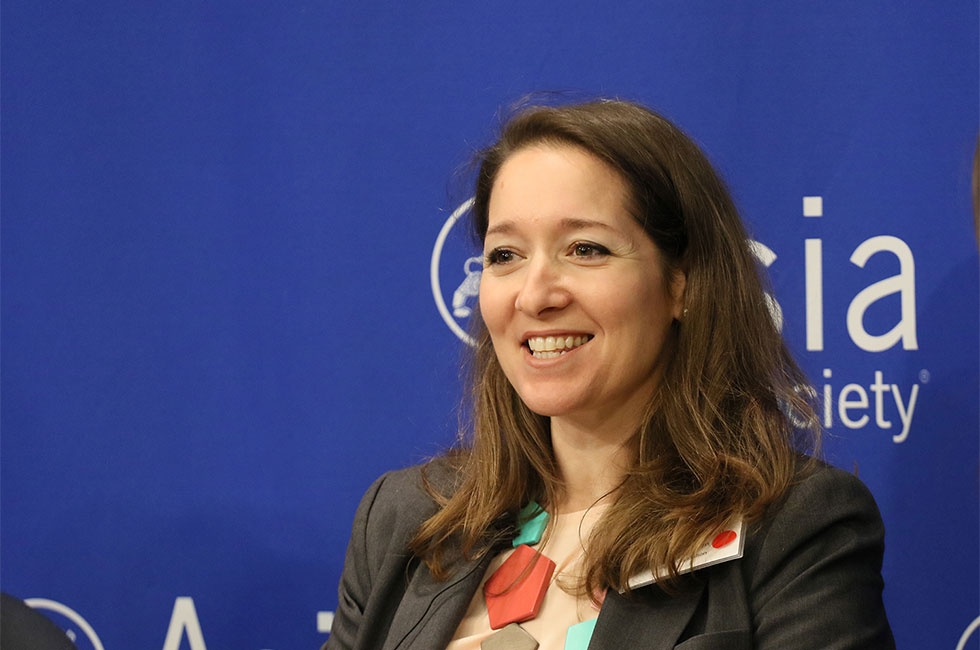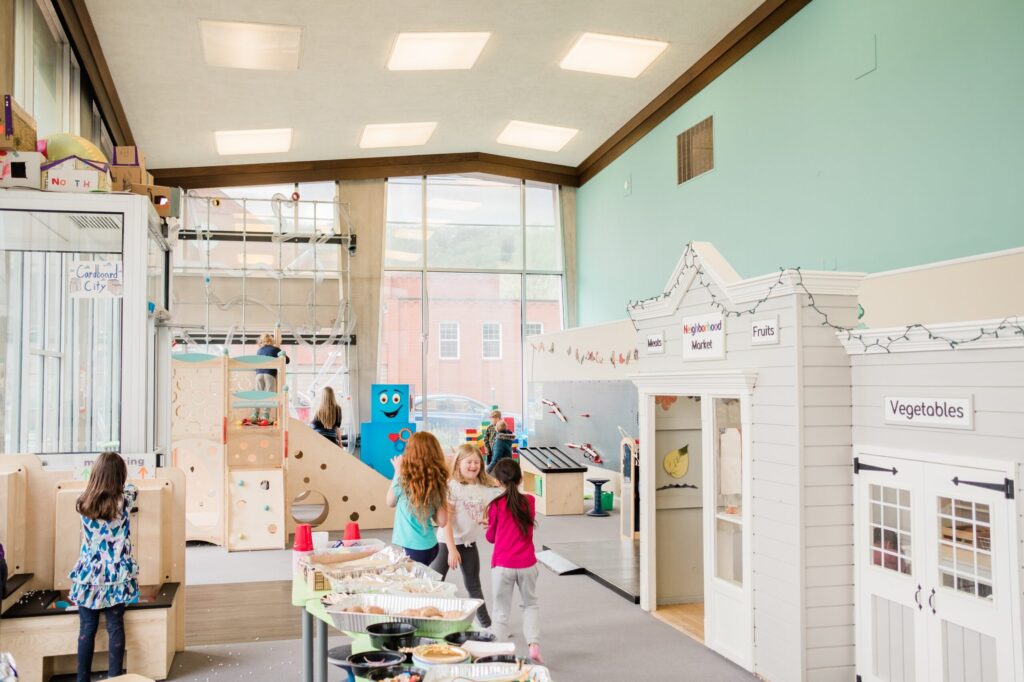The experience of play can bring joy and spark curiosity, teach us new concepts and skills, even help us forge deeper relationships with ourselves and those around us. So says Sarah Wolman, founder and CEO of Lightbulb Learning Lab.
“Every child needs play,” Wolman says, “and adults do, too.”
Wolman is an expert in play and early childhood development. She addressed an invited cohort of Pittsburgh-based community organizations at a workshop on August 28th to develop ideas for playful learning projects in and around Pittsburgh. We spoke with Sarah about the value of play, the ways it can connect generations and how it can uplift whole communities.

Remake Learning: Why is play valuable – for learning, for child development and for communities?
Wolman: When we think about the whole child, researchers often talk about developmental domains – physical, social, emotional, cognitive, creative. Different frameworks split them up or combine them in different ways, but research shows that play can provide benefits across all these domains.
All play has benefits. Just one example: A child sliding down a playground slide with friends is benefitting physically, but they might also be learning socially by waiting their turn or even cognitively, if there is dramatic play happening. What we know about neuroscience is that “what fires together, wires together,” which means that the neural pathways that get used in the brain grow stronger.
So all kinds of play, from playground play to games to dramatic play, can generate its own benefits. But there is a specific kind of play that can have deep benefits for learning, and we call this playful learning or learning through play. Playful learning experiences can easily advance development across all of the developmental domains by offering a kind of hands-on, minds-on experience.
Picture a group of students building with LEGO bricks, asked to use various pieces to build something, let’s say a duck. They are using and building dozens of different skills during that one small activity. Long term memory (remembering what a duck looks like), short-term memory (remembering the instruction), attention, cognitive flexibility, fine motor skills, spatial reasoning and so many more. They’re also building symbolic representation when thinking, “Oh, this rectangle could be the duck’s bill …” For young children, early literacy and early numeracy are profoundly dependent on symbolic representation; reading and math are really just systems of symbols!
Playful learning benefits adults, too, and it strengthens the relationships between adults and children. This can be especially important where children (and adults) are facing serious challenges from trauma or toxic stress. Amazingly, play has been shown to mitigate the effects of toxic stress.
At the community level, playful learning can have a big impact on our environments and experiences of a place. When we build a playful learning installation in the places children and families already spend time, we can benefit children, adults and families. We can also enliven public spaces. And in the process these installations can make a kind of statement. It’s saying, “This community cares about one another. We care about our experiences and want this to be a positive, joyful place. We support one another as caregivers and want to support children’s learning and development.” Done well, playful learning spaces are designed with input from community members. It’s less of a top-down “someone put this here for me” experience and more a feeling of “we have decided to put this here for our community.”
Remake Learning: What is a playful landscape? How does play show up in public spaces and our everyday lives, and how can that improve lives and communities?
Wolman: Playful learning landscapes can take so many forms, from temporary experiences to permanent structures. In Philadelphia, a project called Supermarket Speak put signage in grocery stores inviting shoppers and their children to identify colors, types of fruit, etc. The project had a budget of $60, but research showed a 33% percent increase in parent-child talk. This simple intervention created an opportunity for parents to talk with young children while they’re in the store, and we know science that tells us what happens in a baby’s brain when we talk to them. That’s how language develops.
That’s a light touch project in terms of cost, time, effort and permanence. At the other end of the spectrum we have permanent structures like Urban Thinkscapes, where benches at bus stops have puzzles built in. These approaches can be especially effective in what we call “trapped spaces” where children spend a lot of time following adults around. Laundromats, grocery stores, bus stops. That’s life. Kids often have to just come along while we go about our lives. But all of this time doesn’t have to be devoid of engagement or stimulation.
Some of the work on playful learning landscapes emerged from research around the amount of time that kids spend outside of school and thinking about learning opportunities for children in the hours when they were not in school. But children’s learning is only one level of the benefit. For adults, there is the potential to decrease stress and increase the executive function and skill development that is valuable for them as caregivers. There are also the benefits to the caregiver/child relationship from these kinds of environments – the opportunities for adults and children to interact in playful ways. And then there are benefits at the community level when we’re offering an invitation into a play experience.
Remake Learning: Tell us about intergenerational play. Why is it valuable and what is it about play that makes it suitable for intergenerational engagement?
Wolman: We know that the presence of joy in the playful experience promotes deeper learning. Though every experience might not make you smile or laugh, the research talks about joy as the unexpected. There’s some aspect of wonder. Every time you roll the dice, something different comes up. We also know that shared joyful experiences helps build and strengthen relationships. And we know that the social experience of shared play leads to deeper learning. So in all of these ways, play is really valuable between children and adults.
We are always experimenting with how to engage adults and children together, which isn’t always easy. On one end of the spectrum, you end up with adults on their phones or talking to other adults. And there is value to having children play with other children. of course! But when we are trying to promote that interaction, we have one end of the spectrum where the adult is not engaged.
Then we have the other end where adults take over the task. In a project with Sesame Workshop called Play Every Day funded by the LEGO Foundation, we found in several countries that there were conditions that would lead caregivers to take over the task. For example, if scissors were involved, adults would take over. So we had to work to find activities that would engage children and adults together, and that’s what we’re always thinking about. We want to be really intentional in how we set up intergenerational play experiences. The design is really critical.
Ideally, we design activities and installations that foster that interactivity. It doesn’t have to be complicated: A parent serving leftovers for dinner can turn that experience into play by involving a child in dramatic play. They can ask the child to take orders from the whole family from the family “restaurant.” It’s that little switch that says, “How do I turn this into a playful experience?” You can imagine pretty easily all the things your child gets out of that. With just that little bit of reframing, you can promote literacy skills (as they write down the order), listening skills and more. And dramatic play is one of the most powerful forms of play for learning.
When we think about the benefits we want to see for children, families and communities, it really makes the case for injecting a lot more play – and specifically playful learning – experiences into our everyday lives.
